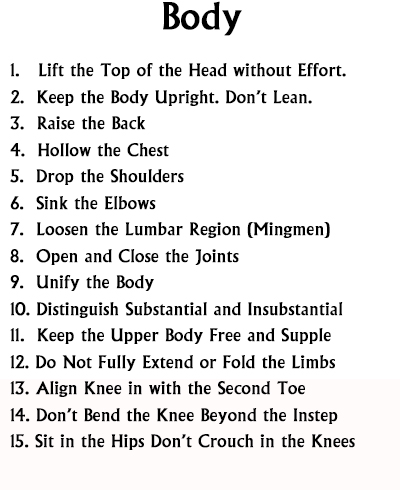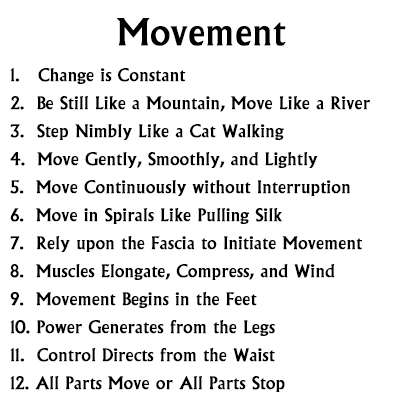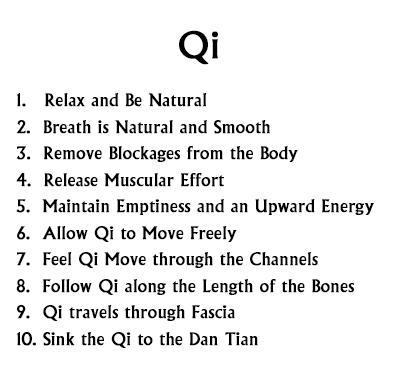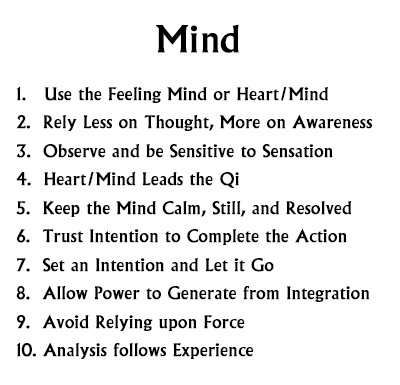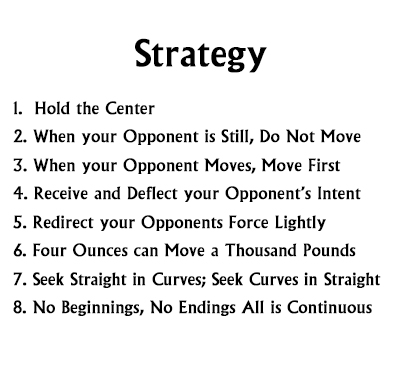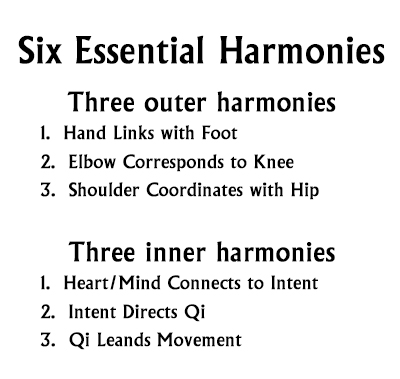
Principles
Taijiquan's principles are like the Ten Commandments. They designate alignment, effort, and execution.
The Rules of the Road
Taijiquan is unusual in that there are collected writings articulating the principles. Those writings are known as the Taijiquan Classics. Recorded by scholars and martial artists who studied with some of the most notable Taijiquan masters of the past. For English readers, there are excellent translations of these texts published in books and on the Internet. To become truly adept at Taijiquan requires study of the classics as well as anatomy, philosophy, fighting, and healing.
The principles begin with a set of physical guidelines that direct the practice. The forms and movements of Taijiquan are specifically choreographed to teach basic skills. By acquiring these skills, you gain deep knowledge first of yourself and secondarily of others.
The Doorway to Understanding
One of the most rewarding aspects of practicing Taijiquan is its infinite capacity for development. To pursue it fully, you can spend a lifetime experiencing revelations and discovering nuanced understandings of its profound teachings. If you so choose, Taijiquan can be a pathway you follow toward spiritual completion and enlightenment.
The access point of the Taijiquan journey begins with physical elements. Its principles remain immutable, while your comprehension of them ceaselessly grows. If you continuously seek their meaning and refuse to compromise their dictates, you will be rewarded with a lifetime of discovery and satisfaction.
The chief difficulty is to discern the correct application of the principles. It is easy to mistake their meaning. If you sincerely seek their meaning without imposing other ideas onto them, your comprehension will deepen. Since it is so easy to deviate from the principles, and since it is so easy to misinterpret their meaning, working with a teacher who is traveling ahead of you on the path is essential to your development.
It’s quite normal when you gain a new understanding of an old idea, to describe your revelation with the words you have used and heard a hundred times before. You often hear students exclaim, ‘Oh you mean, relax,” as though they had never heard that instruction before. The revelation happens through experience. Understanding and analysis, giving words to the experience are translated through the intellect whereas experience is felt.
Getting on the Path
You begin learning the fundamentals as a solo practice. Many of the basics are taught as warm-up exercises. There are exercises designed to help release excess tension—particularly in the shoulders. Other exercises teach you how to move your waist and lead your movements from there. Still other exercises teach you to rotate each of your legs independently in your hip joints.
Opening and Stretching the Joints
Stretching in Taijiquan is different than other disciplines. The flexibility required for Taijiquan skills are the capacity of the joints to stretch open and then close. These movements are quite small relative to the way you can move the bones.
The movements of Taijiquan are internal. In the grossest way, those movements happen in the torso—particularly the spine. Power is generated by not displacing the bones. Power, like Qi, passes through the bones. It follows the shape of the body as opposed to movements that relocate the body. The stretching follows the shape of the body as it is, rather than folding the joints and lengthening the muscles on one side as you might in other forms of stretching.
Taiji stretching is more like applying traction to the length of the bones. It follows the direction of the long bones all the way out the fingers and toes. This principle is about opening and closing the joints. This is different than bending and unbending the joints. By moving the Jin (trained power) through a unified body, every part supports the same mission at the same time. Joints can be the weak point of power transmission, if they do not support a common purpose and bend under a load. When the joints maintain their integrity, and the generation of power travels from the ground through the belly, up the spine, and out the arms to the fingers without being dissipated, the power is full.
Muscles as Secondary Support for Movement
In the Taijiquan Classics the admonition is for the mind to lead the Qi and the Qi to lead the body. Training gradually cultivates the ability to perceive the difference between the normal way of moving in which the mind goes directly to the body. In untrained movement, you have an intention to do something, say open a door. Without any particular thought, your arms and hands move to turn the doorknob and pull open the door. In Taijiquan, you acquire a feeling in the body that precedes movement. Your awareness of sensation in your arm and hand precipitates the movement. Initially this requires a delay in accomplishing the task. It's a major reason you see Taijiquan being practiced slowly. As you learn, it takes time to acquire and recognize the sensation of Qi.
Whereas untrained movement is dominated by the muscles. In Taijiquan, you shift from the muscles being the primary instigator of movement and allow the connective tissues i.e., the fascia, the tendons, and the ligaments, become the primary leader of movement. Because these tissues are far less innervated, it is difficult to recognize them at first. Over time of training, you learn to keep the muscles in a dynamic relaxed state (Song), and the movement proceeds with the least amount of effort possible to accomplish the task.
As you are training your Taijiquan skills, you begin by limiting the range of movement of your extremities. This is especially true of the flexion of your knees and elbows. When these to joints become primary and bend too far, you choke off the ability to rely upon the fascia to suspend the workload. When you lower your stance, you want to flex primarily in your hip joint. This is called the Kwa in Chinese and refers to the inguinal fold where the top of the femur connects to the pelvis. The Kwa is a rotating joint whereas the knee is a hinging joint. Similarly, the shoulder is a rotating joint while the elbow is a hinging joint.
Many people make the mistake of attempting to get too low in their stances for their own body types. The fantastically low stances you see in demonstrations in videos of masters and young children are not possible to replicate if your training began later in life when the flexibility of the hip joints is more limited.
Another problem that is frequently found in Taijiquan practitioners who are too aggressive with their ambitions to have ultra-low stances is that the strain in the knees reflects in the lower back. The knees should be pass-through joints. They are not equipped to bear the weight of your body. Often when the knees are over bent, it can lead to injury. Since the knee bending and lower back tension are interrelated, two of the major injuries that occur among Taijiquan practitioners take place in the knees and lower back. By using the hips properly and getting permission from your body to release down into your stance by receiving the weight into the hips and knees, you can remedy many back and knee problems.
In terms of the arms, the postures in the Taijiquan form begin training the elbow joint flexion ranges from between approximately 90° and 150°. The limitations placed on the bending initially help train the dynamic feeling of intrinsic strength. Rather than relying on muscle to hold the position, the feeling that passes through the arm in the direction of the long bones, a feeling like water shooting out of a hose, maintains the strength. Your arm becomes like a tree branch. It bends, it flexes, but it doesn't snap and fold.
One of the key skills is to be able to maintain a still place from which movement stretches and pivots. Developing this ability requires much diligence over a long period of time. Just as a compass needs a still center to inscribe a circle, or a drill needs a fixed center to accurately make a hole, in Taijiquan power can be expressed when there is an unmoving pivot point.
Violating the Principles
Normal, untrained human movement rarely comports to the movement principles of Taijiquan. One of the glaring errors can be described in several ways. Freezing. Insisting. Resisting. Defying. The quality of liquid water is that whenever it encounters an obstacle it reshapes itself around the object as it finds the path of least resistance. In Taijiquan the notion of yielding, or giving over territory to an opponent is an error. In the case of both water there is no change in volume. In the case of circles, the is movement but not displacement. The error of double-weightedness is an indication that there are two centers. Once this error occurs the option of rotating is nullified. Just as when water freezes, it no longer has the ability to move around an object.
The ability to roll around an obstacle, whether it is the force of an incoming blow, or a push is a key skill of Taijiquan. Both examples are linear forces with a singular direction. Being able to rotate at the point of contact so that the force is dissipated without you having to relinquish any territory is an appropriate Taijiquan response. To be able to rotate requires having a center. The center allows for the free rotation. In the Taiji philosophy is having both stillness (Yin) and motion (Yang).
The rotation may include an inward or outward aspect, In a fight or push hands situation you do not need to remain in a fixed position. Maintaining Central Equilibrium while relocating your body means maintaining an upright relationship with gravity. Stepping while rotating initiates a spiral action like the action of a drill.
